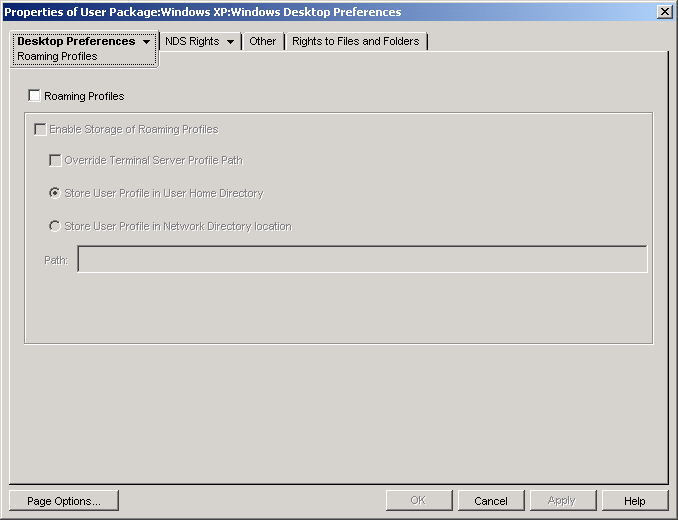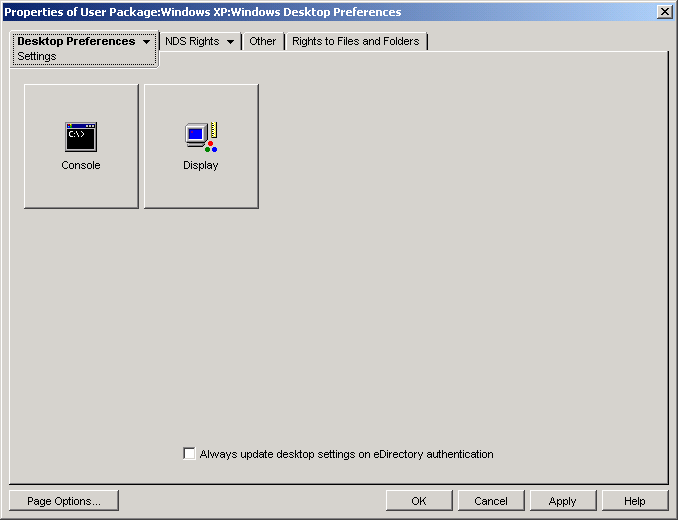15.8 Windows Desktop Preferences Policy (User Package)
Allows you to enable roaming profiles and apply desktop settings.
When a user logs on to a Windows 2000/XP workstation for the first time, Windows creates a user profile: a data file associated with that user containing information that defines customized desktop environments, which include individual display settings, network and printer connections, and other specified settings. The user profile maintains the desktop settings for each user’s work environment on the local computer.
According to information on the Microsoft Web site about user profiles, there are three types of user profiles:
-
Local user profile: A local user profile is created the first time a user logs on to a computer and is stored on a computer’s local hard disk. Any changes made to the local user profile are specific to the computer where the user made the changes.
-
Roaming user profile: A roaming user profile is created by the system administrator and is stored on a server. This profile is available every time a user logs on to any computer on the network. Changes made to the user’s roaming user profile are updated on the server. For more information on creating a roaming profile in ZENworks, see Section 15.8.1, Setting Up the Windows Desktop Preferences Policy in ConsoleOne.
Normally, a user profile works on just one workstation or Terminal Server, but a roaming profile follows the user regardless of where the user logs in, so each network workstation or Terminal Server where the user logs in always has the same appearance. If the applications are stored on the network, the user also has access to the same applications.
-
Mandatory user profile: A mandatory user profile is a roaming profile that can be used to specify particular settings for individuals or an entire group of users. Only system administrators can make changes to mandatory user profiles.
You can enable a roaming profile or a mandatory profile and specify where the profile is to be stored. How changes to that profile are handled depends on the profile type.
This section includes information you can use to set up Windows user profiles (called in ZENworks) to manage the user’s desktop settings:
15.8.1 Setting Up the Windows Desktop Preferences Policy in ConsoleOne
To set up the Windows Desktop Preferences policy:
-
In ConsoleOne, right-click the User Package, click , then click the appropriate platform page.
For more information about Desktop Management support for the Windows NT platform, see
Interoperability with Windows NT 4 Workstations
in the Novell ZENworks 7 Desktop Management Installation Guide. -
Select the check box under the column for the Windows Desktop Preferences policy.
This both selects and enables the policy.
-
Click to display the Roaming Profiles page.

-
To enable roaming profiles, set the desired parameters in the following fields:
Roaming Profiles: Select this check box to enable roaming profiles. When you enable this check box, the other options on this page become available.
Enable Storage of Roaming Profiles: Select this check box to enable the storage of roaming profiles. This option allows profiles to be stored on a network server where they can be accessed from any workstation. Choose from the following options to specify how you want roaming profiles managed:
-
Override Terminal Server Profile Path: If the user is accessing a Terminal Server that has its own profile, enable this option to override the Terminal Server’s profile and use the roaming profile stored in the user’s home directory or the profile stored in the network directory location specified in the Path field.
-
Store User Profile in User’s Home Directory: Stores the roaming profile on the network in the user’s home directory. This allows the user to utilize the same desktop environment on all workstations throughout the network. Any changes made to the user’s environment on one workstation are saved to the profile stored in the user’s home directory on the network. The environment specified in the profile is then available on any workstation where the user subsequently logs in.
-
Store User Profile in Network Directory Location: Stores the user profile in a network directory. When you choose this option, the user profile is stored on the network and users who have their roaming profiles pointed to this location share this profile. If you use %USERNAME% environment variable, the variable is resolved with the corresponding user’s roaming profile. Any changes that users make to the profile are saved in the network directory location.
-
Path: Specify the UNC path to the user’s profile.
IMPORTANT:If roaming profiles are to be stored on a NetWare file system, either the Novell Client is required or CIFS needs to be installed on the NetWare server; CIFS lets workstations access the NetWare file system without needing the Novell Client.
You can store roaming profiles on a Windows server if the workstations are not running the Novell Client but are running the Microsoft SMB client.
-
-
Click the down-arrow on the tab, then click .

-
Click either the or button to display a dialog box that shows the options available for each feature.
This page displays icons matching the equivalent desktop features in Windows 98 or Windows NT/2000/XP.
See your Microsoft Windows documentation for help on these features and their options.
-
(Optional) Select the check box.
-
Click to save the policy.
-
Repeat Step 1 through Step 8 for each platform where you want to set desktop preferences.
-
When you have finished configuring all of the policies for this package, continue with the steps under Section 15.13, Associating the User or Workstation Package to associate the policy package.
15.8.2 Accommodating Roaming Profiles on a Slow Network
In ZENworks for Desktops 4.x, if a slow link was detected that would require significant time to download a roaming profile, you could set registry keys to automatically download the roaming profile, use the locally stored profile, or display an instructional dialog box to let the user choose to either continue the download or to use the locally stored profile. This functionality is no longer supported in ZENworks 7 Desktop Management. All roaming profile processing is now handled by Microsoft code.
This functionality is provided by the Microsoft native support for slow link detection. The Microsoft Group Policy Editor should now be used to configure slow link detection.
15.8.3 Setting Up a Mandatory User Profile
You can create a default mandatory user profile appropriate for the tasks that a user or a group of users performs. The mandatory user profile does not save changes to the desktop settings made by the user. Users can modify the desktop settings of the computer while they are logged on, but none of these changes are saved when they log off. The mandatory profile settings are downloaded to the local computer each time the user logs on.
A mandatory user profile is a roaming profile, following the user wherever he or she logs on. It is created in ConsoleOne using the same procedure used to create roaming profiles (see Section 15.8.1, Setting Up the Windows Desktop Preferences Policy in ConsoleOne) but with some important differences:
-
Make sure you set the appropriate access permissions for the user or groups of users that will use this profile. This is most easily done by storing the profile in a network directory location where all users have Read rights.
-
When the user profile, ntuser.dat, has been stored in the designated network location, rename it to ntuser.man. User profiles become mandatory (Read Only) when you rename them with the .man extension.